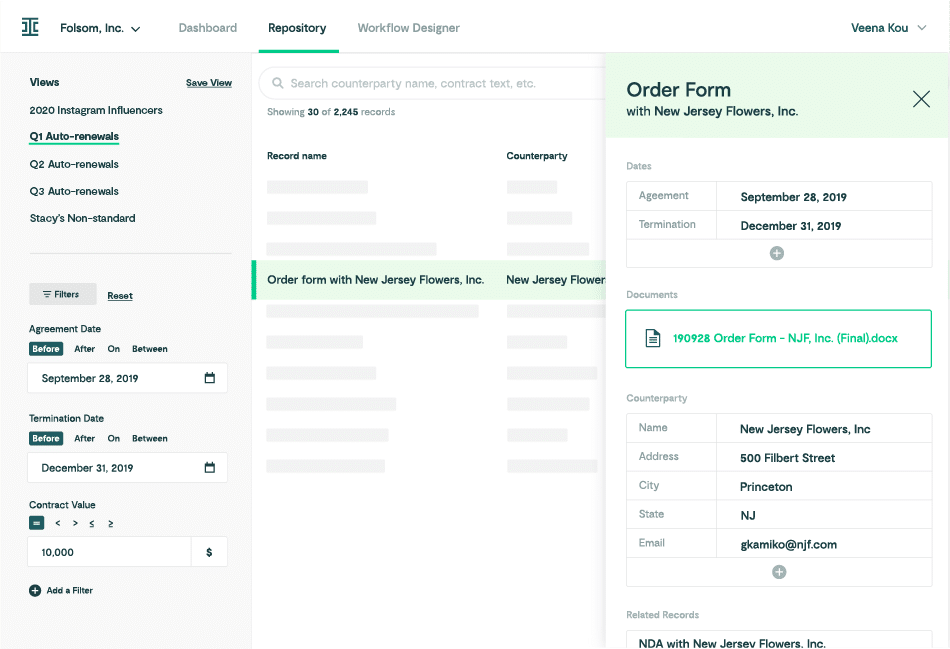Legal technology can do amazing things to streamline and improve your business operations. The right tools can help you automate processes, surface decision making data, save time, reduce the risk of errors, and capture reusable knowledge. But with so many legal tech options on the market, it can be overwhelming and hard to know where to start.
If you’re ready to invest in legal tech — and you should be! — here are some tips to help you make the best buying decisions:
What’s the problem?
First, identify the problem you’re trying to solve. Don’t go walking around your company wielding software like a hammer looking for nails. When general counsels and executive leaders hear about a new technology, like AI, they’re prone to ask questions like, “Where can I use AI?” This is backwards thinking! Don’t hunt for use cases. Start with the problem first, then look for solutions that can help solve it.
You also may not need a new piece of technology at all. More than once in my own career, I’ve been asked to purchase a new tech solution only to find out we had a people and process challenge that was solvable without tech. Identifying the problem at hand goes a long way toward helping you find the right solution.
Don’t just do as you’re told.
People tend to like what we’re used to. Your in-house lawyers have no doubt told you they want a document management system (DMS), but only because that’s what they used at their old firm. DMS works really well at a law firm but, for many reasons, often does not work well in an in-house environment!
Again, start with the actual problem that you’re trying to solve. Keep asking why. In most cases, what your lawyers really need is a repository for their contracts. That’s because 90% of the documents they want to find are, in fact, contracts. A contract lifecycle management solution (CLM) is going to make those lawyers much happier in the long run, even if they’ve never heard of CLM before.
Gather business requirements — but don’t ask for them!
You’ll likely have a lot of stakeholders to please and getting them aligned is always your main goal. One thing I learned during my time at Google was how to ask the right questions. If you go around asking people what their system requirements are, they’ll likely tell you what tech they need to enable their current — and presumably broken — process. In addition, you’ll end up with a long list of each team’s impossible to meet “must haves.” A list that, later on, will give your stakeholders reasons to push back on any and all tech because there will never be one solution that fulfills all their initial demands. This can then lead to a lack of trust and partnership because they may wind up feeling like their voices were not heard.
Instead, get a clear picture of how things currently work – what is working well, and what could be better. This way, you’re not asking for what they want in a new system, but again focusing on the real issues or root cause of problems and painting for them a picture of what a future state could look like, how it would make life easier, improve controls, reduce risk, etc. The real key to stakeholder alignment is not getting everyone to agree on a feature set, but rather to simply agree that there is likely a better way to do things.
Figure out your legal ops change strategy.
Lawyers have a tendency to want to do everything perfectly from the start. They want to roll out a system for everyone at once, but wall to wall implementations are challenging. You’ll likely be looking at replacing a bunch of legacy systems and disparate processes, which means trying to align countless stakeholders who may not even think anything is wrong with their current setup. Why walk into an uphill change management battle before you even get started?. Instead, consider the “land and expand” strategy. Why not land and expand, instead?
Find willing parties, like teams who are eager to experiment or desperate to try a new way of doing things. Launch, iterate, and achieve success with these first adopters, and word will spread across the company. Lawyers are competitive and when they see that success, they will beg you to roll out the tools to their teams too. As I always say, the best change management is no change management. When they are able to see the immediate value and impact for themselves, they will come to you. Other teams will want to join in when they see how much better life is with a new legal ops process backed by a better piece of technology.
Pick a partner who cares.
Once you’ve got a clear picture of what you really want and need from a legal tech solution, it’s time to pick a technology partner. Choosing the right vendor and solution is a topic worthy of its own blog post, but it usually comes down to this one rule of thumb: Pick a partner who cares about your success. However big or small your company and needs, partnering with a vendor who’s invested in your prosperity will go a long way towards winding up with a tech solution that really supports and augments your business.
To paraphrase from a great post I recently saw on LinkedIn, there are three rules for buying software:
- There is no perfect solution.
- Never sacrifice majority value for a feature you’re likely only going to use once or twice.
- It’s not just about the software. Evaluate the people, culture, and support that come with the technology.
Good technology can do a lot to augment and support the capabilities of a legal function. But only if you’ve got good people surveying the situation and identifying the right problems for tech to help solve. Draw on your experience and savvy, legal ops friends, and you can select the right solution and partner to drive real value for your business.
Ironclad is not a law firm, and this post does not constitute or contain legal advice. To evaluate the accuracy, sufficiency, or reliability of the ideas and guidance reflected here, or the applicability of these materials to your business, you should consult with a licensed attorney. Use of and access to any of the resources contained within Ironclad’s site do not create an attorney-client relationship between the user and Ironclad.




